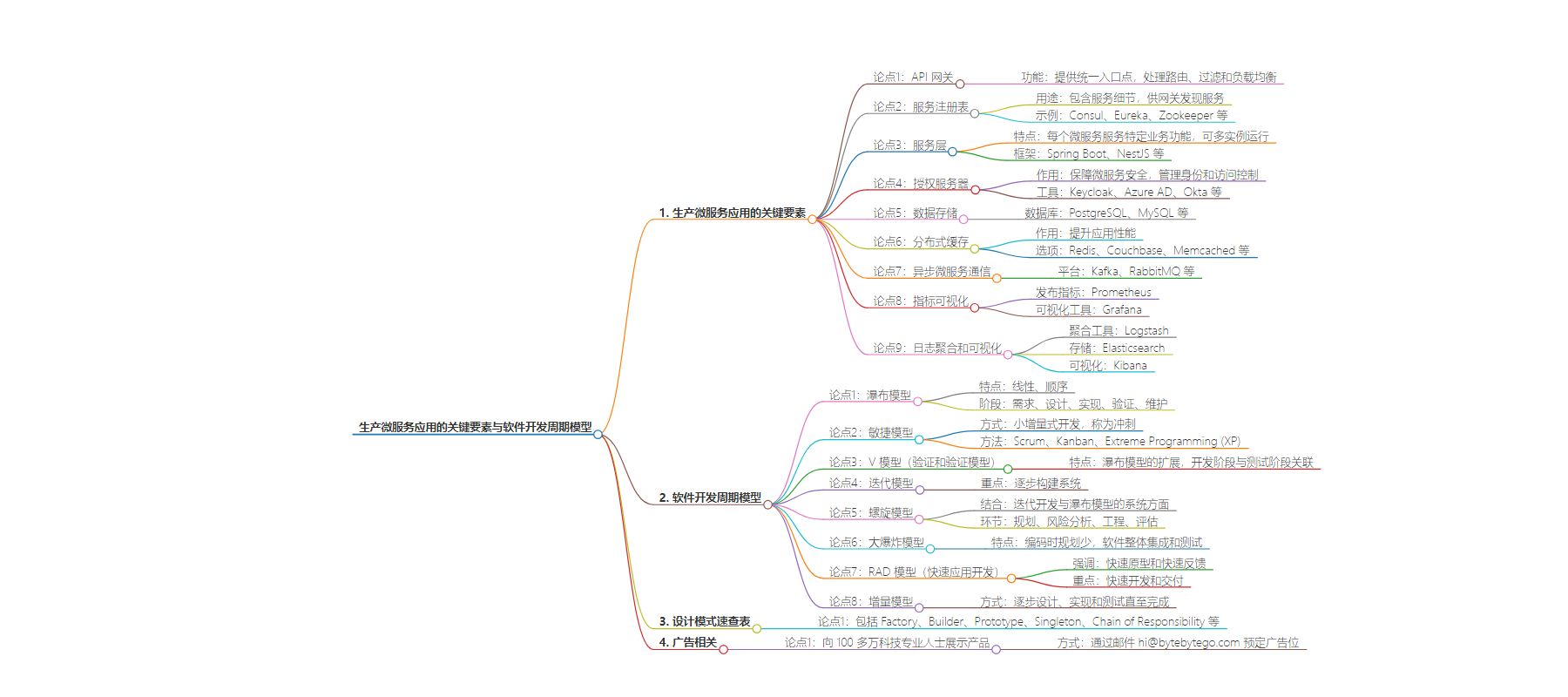包阅导读总结
1. 关键词:Microservice、Production、Software Development、Models、Cheat Sheet
2. 总结:本文涵盖了生产微服务应用的关键组件、软件开发周期的常见模型,以及设计模式的 cheatsheet 等内容,并提及了测试优化工具 QA Wolf 和推广渠道。
3. 主要内容:
– 生产微服务应用:
– 9 个关键组件,如 API 网关、服务注册中心、服务层等。
– 软件开发周期模型:
– 介绍了 Waterfall、Agile、V-Model 等常见模型及特点。
– 设计模式 cheatsheet:
– 包含 Factory、Builder 等多种模式的简要解释及使用方法。
– 测试优化工具:
– QA Wolf 可加快测试周期,提升开发团队发布速度。
– 推广渠道:
– 介绍通过特定邮件推广产品和服务的方式。
思维导图:
文章地址:https://blog.bytebytego.com/p/ep121-9-essential-components-of-a
文章来源:blog.bytebytego.com
作者:ByteByteGo
发布时间:2024/7/20 15:30
语言:英文
总字数:788字
预计阅读时间:4分钟
评分:89分
标签:微服务,系统设计,DevOps,API 网关,服务注册表
以下为原文内容
本内容来源于用户推荐转载,旨在分享知识与观点,如有侵权请联系删除 联系邮箱 media@ilingban.com
This week’s system design interview:
-
Linux Crash Course – Understanding File Permissions (Youtube video)
-
9 Essential Components of a Production Microservice Application
-
Iterative, Agile, Waterfall, Spiral Model, RAD Model… What are the differences?
-
Design Patterns Cheat Sheet – Part 1 and Part 2
-
SPONSOR US
Are slow test cycles bottlenecking your dev teams’ release velocity? With QA Wolf, your organization can run entire test suites in minutes for faster feedback and developer confidence to ship.
QA Wolf takes testing off your plate. They can get you:
The benefit? No more manual E2E testing. No more slow QA cycles. No more bugs reaching production.
With QA Wolf, Drata’s team of 80+ engineers achieved 4x more test cases and 86% faster QA cycles.
🌟Rated 4.8/5 on G2
Schedule a demo to learn more
-
API Gateway
The gateway provides a unified entry point for client applications. It handles routing, filtering, and load balancing. -
Service Registry
The service registry contains the details of all the services. The gateway discovers the service using the registry. For example, Consul, Eureka, Zookeeper, etc. -
Service Layer
Each microservices serves a specific business function and can run on multiple instances. These services can be built using frameworks like Spring Boot, NestJS, etc. -
Authorization Server
Used to secure the microservices and manage identity and access control. Tools like Keycloak, Azure AD, and Okta can help over here. -
Data Storage
Databases like PostgreSQL and MySQL can store application data generated by the services. -
Distributed Caching
Caching is a great approach for boosting the application performance. Options include caching solutions like Redis, Couchbase, Memcached, etc. -
Async Microservices Communication
Use platforms such as Kafka and RabbitMQ to support async communication between microservices. -
Metrics Visualization
Microservices can be configured to publish metrics to Prometheus and tools like Grafana can help visualize the metrics. -
Log Aggregation and Visualization
Logs generated by the services are aggregated using Logstash, stored in Elasticsearch, and visualized with Kibana.
Over to you: What else would you add to your production microservice architecture?
If you’re not a paid subscriber, here’s what you missed.
-
A Crash Course on Relational Database Design
-
A Crash Course on Distributed Systems
-
A Crash Course in Database Scaling Strategies
-
A Crash Course in Database Sharding
-
A Crash Course on Microservice Communication Patterns
-
A Crash Course on Cell-based Architecture
To receive all the full articles and support ByteByteGo, consider subscribing:
The Software Development Life Cycle (SDLC) is a framework that outlines the process of developing software in a systematic way. Here are some of the most common ones:
-
Waterfall Model:
– A linear and sequential approach.
– Divides the project into distinct phases: Requirements, Design, Implementation, Verification, and Maintenance. -
Agile Model:
– Development is done in small, manageable increments called sprints.
– Common Agile methodologies include Scrum, Kanban, and Extreme Programming (XP). -
V-Model (Validation and Verification Model):
– An extension of the Waterfall model.
– Each development phase is associated with a testing phase, forming a V shape. -
Iterative Model:
– Focuses on building a system incrementally.
– Each iteration builds upon the previous one until the final product is achieved. -
Spiral Model:
– Combines iterative development with systematic aspects of the Waterfall model.
– Each cycle involves planning, risk analysis, engineering, and evaluation. -
Big Bang Model:
– All coding is done with minimal planning, and the entire software is integrated and tested at once. -
RAD Model (Rapid Application Development):
– Emphasizes rapid prototyping and quick feedback.
– Focuses on quick development and delivery. -
Incremental Model:
– The product is designed, implemented, and tested incrementally until the product is finished.
Each of these models has its advantages and disadvantages, and the choice of which to use often depends on the specific requirements and constraints of the project at hand.
The cheat sheet briefly explains each pattern and how to use it.
What’s included?
-
Factory
-
Builder
-
Prototype
-
Singleton
-
Chain of Responsibility
-
And many more!
Get your product in front of more than 1,000,000 tech professionals.
Our newsletter puts your products and services directly in front of an audience that matters – hundreds of thousands of engineering leaders and senior engineers – who have influence over significant tech decisions and big purchases.
Space Fills Up Fast – Reserve Today
Ad spots typically sell out about 4 weeks in advance. To ensure your ad reaches this influential audience, reserve your space now by emailing hi@bytebytego.com
